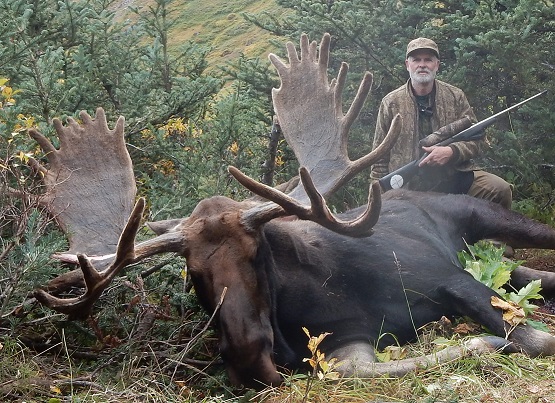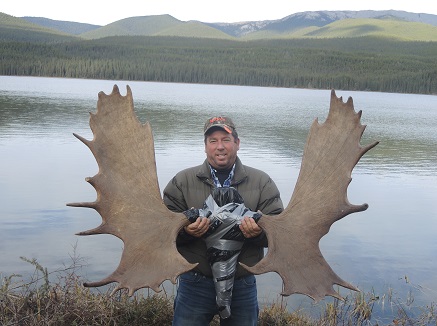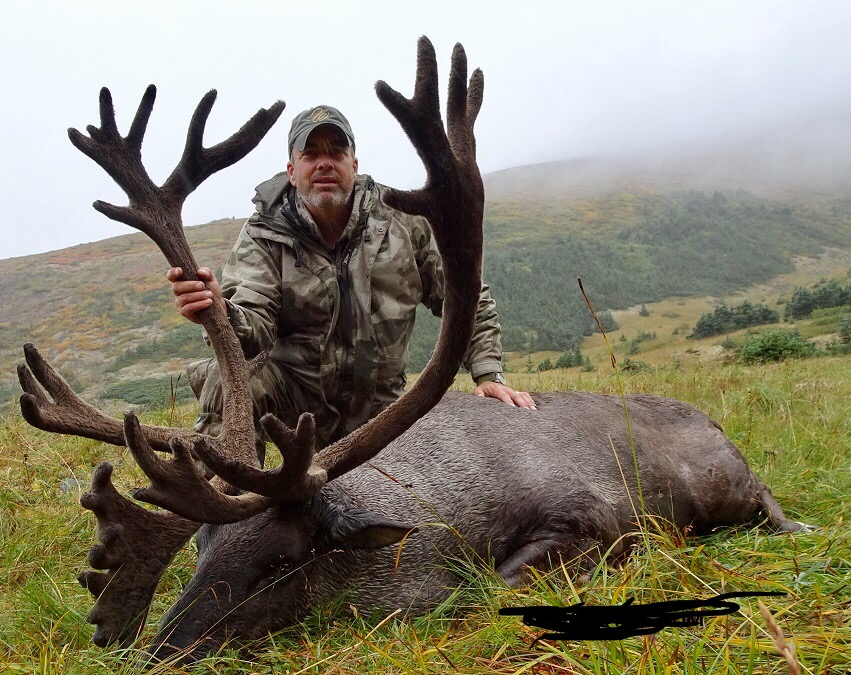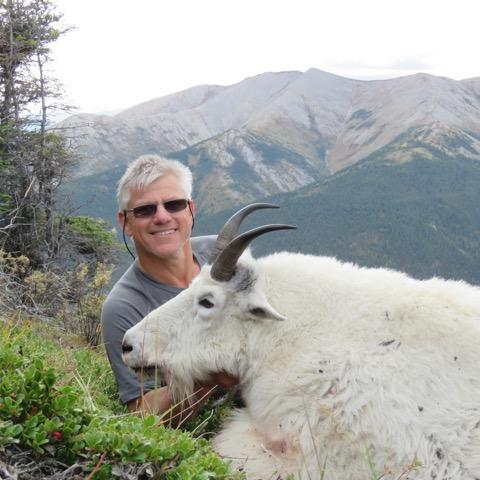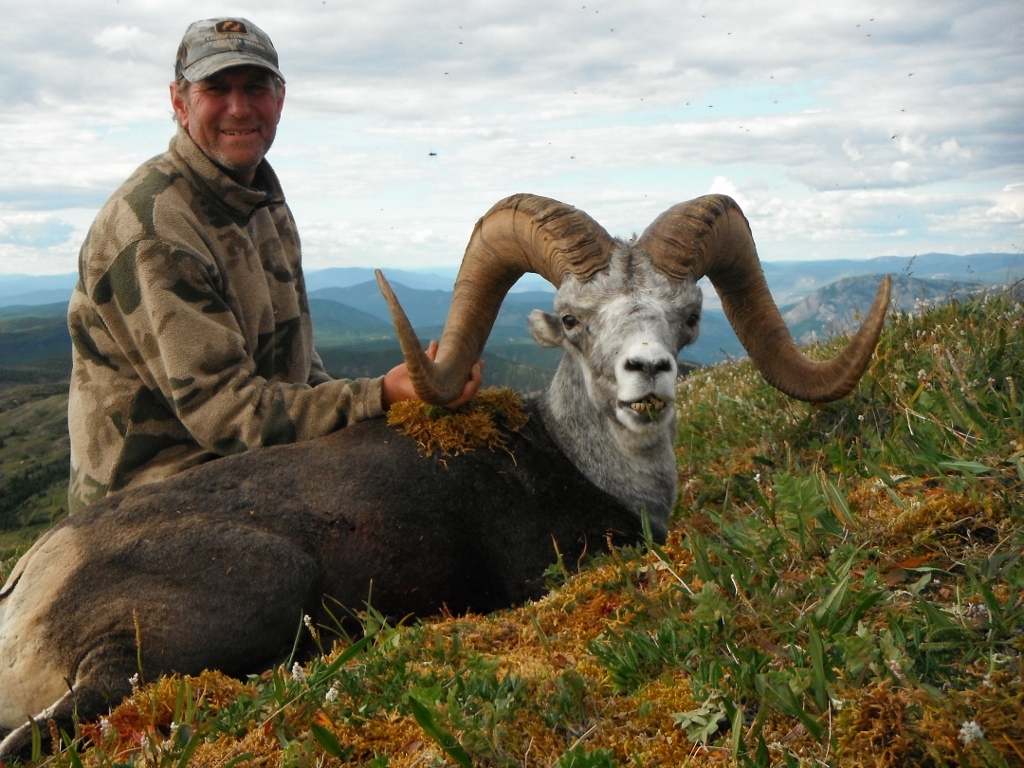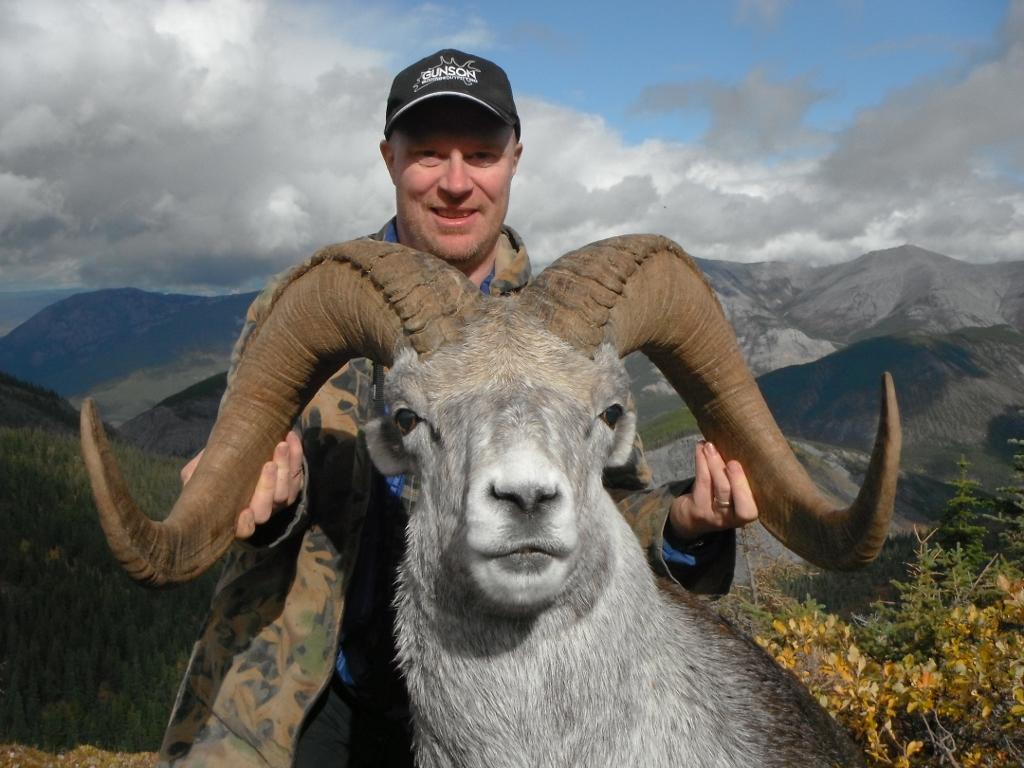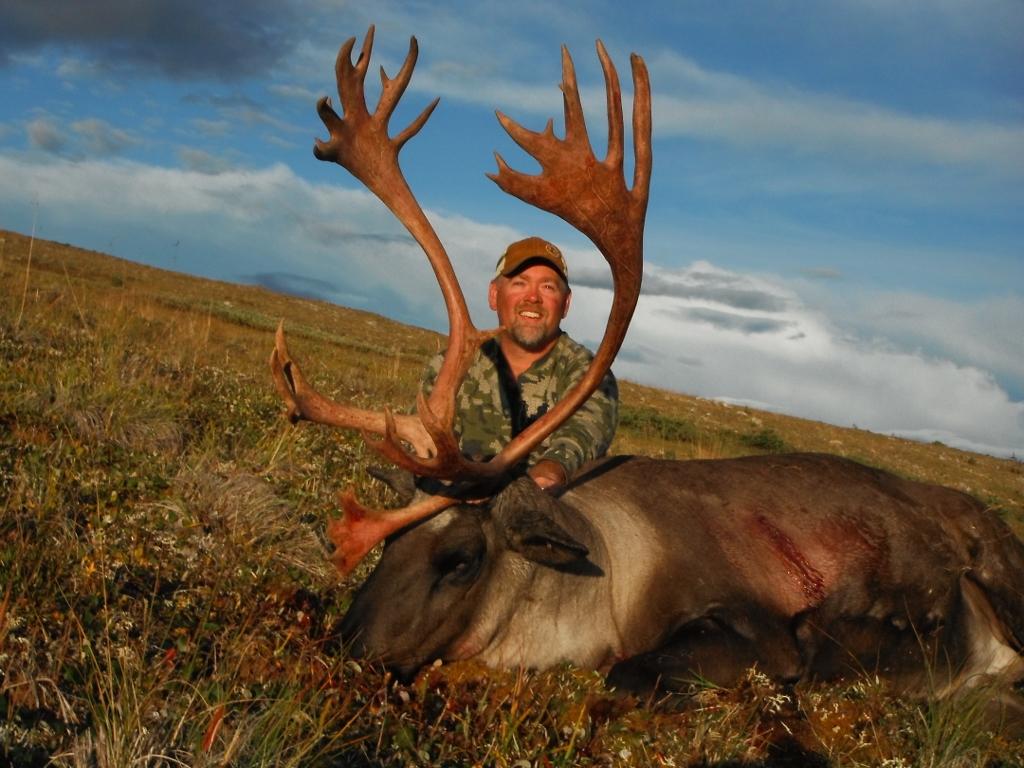If you like the smaller, more family run guiding operations, the kind that caters to hunters first, and numbers of clients second, then you will like this operation. The outfitter has guided in Manitoba, Alberta, the Yukon, the NWT and BC. He now owns this area, and has for about 5 years. He is young BUT VERY experienced, he is hard-charging and he tells it like it is. NO BS! That is everything we like in an outfitter! Add to it an area that produces unusually large moose due to its proximity to the Yukon moose genetics, add to that the very large Stone sheep here, throw in the goats, the black bears and the mountain caribou, and you have the potential for some awesome hunting. The key selling point of these hunts is that they are float-plane access only lakes, and they’re almost all within 20 miles of the BC-Yukon border. If you cross that imaginary line, the price goes up $8,000-$10,000 or more!
Basically they are geared to offer trophy hunts for exceptional quality game, with their Canada moose averaging around 53” and with all their sheep harvested to date having scored over 165” B&C. However, game of this quality is not found in high densities. This hunting concession is located in the far north, meaning the land is simply not that productive, so the game out of necessity is spread over large areas, and can be difficult to find. Game densities are simply lower than most of us are used to. You need to be prepared to hunt hard, be very physical, with no “guarantee” of “success” (assuming you define success as simply making a kill; we think the adventure is the success, and an animal is just a bonus!). With these types of hunt, you are essentially trading quantity for quality.
That being said, they still manage excellent success on outsize Canada moose. Assuming you can shoot straight and are in very good physical condition, expect success on moose to be in the 75% to 80% range. This despite the fact that they are in an area which requires 3 points in front, or 10 on a side! You will not kill a shrimp with those rules, as it basically this has the effect of setting minimum width at around 48”, but most are 53”-56”, and a few get wider. They’re not the widest bulls out there, but they have big paddles, etc., so tend to score very well. Average kill rate is about 80% across all hunts (excluding archery hunts).
Here is a quote from the outfitter on his moose and goats:
“But we don’t get big ones by passing up smaller legal ones – we pretty much kill any legal Stone ram we find; it’s just that they are (almost) all BIG if they’re legal. Kind of like the moose here. We’re still running about 1/3 over 185” on the moose; a couple pushing 200” (or more) this year. And the goats, for that matter. I’m 100% on book goats over the last 2 years.”
MOOSE
This area is only 50 miles from the Yukon border, and the genetics here produce Alaska-Yukon class moose in the 48”-55” range, although classified as Canada Moose. These are huge bulls. They offer basically three moose hunts, which can generally be combined with mountain caribou, goat, black bear, and wolf.
THIS OUTFITTER EXPECTS ALL CLIENTS TO BE IN EXCELLENT PHYSICAL CONDITION, AND HE WILL WANT TO INTERVIEW YOU BEFORE TAKING YOU ON! MOST PEOPLE OVER 200 POUNDS WILL BE TURNED DOWN. HE DOES HAVE SOME EASIER BOAT HUNTS, BUT YOU STILL NEED TO BE PRETTY PHYSICAL TO GET AROUND.
I. HORSEBACK HUNTS: Running basically the month of the September, these hunts are usually done as a combo with black bear or goat. Fly by float plane into your camp on a remote mountain lake where your guide and the horses will be waiting for you. Stay in a cabin (sometimes a tent), or else spike out in the mountains, using horses to help out greatly. This is a great time of year, with good weather, gorgeous country and long hours of daylight. But please, this is rugged country, so be in shape to glass game, then climb and descend until you are in range! Lots of hiking and climbing is usually required to be successful – the horses cannot do it all!
II. LAKE HUNTS: The least physical of their hunts. Note we did not say easy – you still have to climb to get game seen on hillsides, unless fortunate enough to call a moose down to the water, or see them down low. And you will need to get in and out of a boat or canoe and up/down a muddy bank multiple times a day. You hunt along the waterways, and can do as much or as little hiking as you want. Calling will be the prime tactic though, and moose will hopefully come right down to the water. Some lakes have cabins, some with tents, but most are very rustic and typically no more than one or two hunters will use it per year! These hunts often produce some of their biggest moose each year. There is virtually no pressure here on the moose resource.
III. RIVER/CANOE HUNTS: ATVs are used to access a river (so no costly air charters), and you float the river for 2-4 days, calling from shore along the way and making camp as you go. If needed and time allows, you may float different sections of the river. This hunt has historically produced very good results, as the area is difficult to access.
STONE SHEEP
The outfitter guides these personally! He only gets a couple tags a year. His success rate on Stones is about 50%, so this hunt is geared toward hunters who already have a Stone sheep and are now looking for a better one, rather than someone looking for their first. He charges only 50% of the hunt price up front, with the rest payable upon success. This way the client gets a serious hunt, and the outfitter has serious incentive to produce. We like that. Please see his further explanation below. Please also note that most sheep hunters also take moose or caribou.
“I do one to three a year. Killed 3 in the last 4 years, including another one in 4 days in 2017. In 2016, busted our butts, but 2 of my 3 hunters passed up shooter rams; and the 3rd guy had 8 of his 9 days snowed/fogged in, and then left. I guess if you don’t count the first couple years of learning the area, my success is actually around 75%. Physically it is a very tough hunt. We have very few legal rams, but we have some EXCEPTIONAL genetics. Several rams we killed were 40” plus and scored over 167. I doubt that anyone anywhere can match my ‘quality’ average. This year (2017) we killed a smaller broken-horn ram on day 4 – my lady hunter was very happy. No idea if we would have found a bigger one or not. But we don’t get big ones by passing up smaller legal ones – we pretty much kill any legal ram we find; it’s just that they are (almost) all BIG if they’re legal. Kind of like the moose. We’re still running about 1/3 of my moose scoring over 185”, a couple pushing 200” (or more) this year. And the goats, for that matter. I’m 100% on book goats over the last 2 years. Took 1 goat hunter (last year) and killed 1 goat.
“The ideal client already has a Stone sheep and wants a better one. If they’re just in it to check off a list, then it is probably not what they’re looking for because they might not get one. But if someone wants a 40” and/or a ‘book’ ram, their odds with me are as good (or better) than anywhere else. But they have to be prepared to go home with nothing. I show all my sheep hunters lots of sheep, and lots of rams, but the 5-7 year olds don’t always show up when they’re 8.
“SOMETIMES I run a later sheep hunt (if I have a tag available – quotas are issued yearly, sometime in the spring). That is usually offered to the 50% of hunters who didn’t get a ram, before the general public. So that second one’s not on the market yet.”
Vern G. said this:
“I hunted with him for Stone sheep. As far as my hunt, everything was great. I hunted the first of August and was his only hunter in camp as nothing else was in season. I did get my sheep on the sixth or seventh day – an awesome ram that scored 171 and change. I saw moose, grizzly, black bear and caribou almost every day, as well as sheep. Most of the moose we saw were down low and we were up high, but we did see some good bulls almost daily, even though they still had some growing to do. I hunted with him personally plus with his horse wrangler the whole time, and they were both great. Other than the nights before and after the hunt, we were only in camp one other night. Then we moved to spike camp, so Jake was the camp cook. He did an admirable job for being spiked out. He always had plenty of coffee, soup, pancakes, lunch stuff, etc. When in base camp, he and his wife did a great job cooking. The food was good and plentiful. The horses, tents, cabins, equipment were all top notch, especially considering the remoteness of where you are. He had a generator with a full-on freezer in camp to keep food supplies and he was well stocked. As far as going back, I would go back in a heartbeat. He is very knowledgeable and knows his area and animals. His horses are great and well taken care of. He and his family are just good people to be around and make you feel like family the whole time you are there”.
“Going back for the fourth year in a row in 2016. Have taken 3 moose, all over 50” and into mid 50s. Seen many more, even on my high-country sheep hunt. He has a huge area around the river, with part north of the river, part south. The area north of the river is classic moose country – boggy, flat, etc. The area south is the higher sheep area – mountains, but also has good moose and also griz and caribou. I hunted sheep – never got a chance at a shooter, but when you find one it tends to be a big one this far north. Hunted sheep 10 days. Saw about 8 shooter bull moose, took a mid-50s bull. Moose hunts are by horse (my first time), by lake (my second time) and then it was horses in mountains for sheep and took another bull moose. Lots of cabins on lakes for moose hunters. Tents or tarps for sheep. Looking forward to my next trip with him this year!” – Brent S.
MOUNTAIN GOATS
They don’t have large numbers of goats here, but they have 2 stable and huntable populations, and some good ones. They are hardly hunted (usually just 1 hunter per year, and some years none at all). Depending on the area to be hunted, you may need to hike a day to get to the hunt area, or you may be able to hunt right around the lake your float plane lands on. Either way, you need to be able to climb 1,500-2,000 vertical feet up the rocks. Elevations are low, but lots of verticals and no trails. It’s a tough hunt, but “book” goats are around. GUARANTEED TAG – NO DRAW!
2023 PRICES (subject to change without notice; all prices in USD)
REMOTE WILDERNESS TROPHY CANADA MOOSE HUNTS
Horseback, or Lake (boat or canoe), or River (canoe), and/or ATV hunts available.
Price: $16,900 per person, plus tags, 5% tax, approx. $1,500 air charter, meat flight (approx. $1,000, if required)
DATES: September 3-13; September 3-22; September 22-October 1
SPECIAL TROPHY MOOSE HUNTS IN NEWLY OPENED AREA
Same price as above. Call for details.
MOUNTAIN GOAT
Horseback or Backpack Hunts – $12,500 per person
DATES: August 24-September 3; September 3-13
MULTI-SPECIES HUNTS (any two of moose or goat, along with wolf and bear)
DATES AS ABOVE – $22,900 per person
BLACK BEAR
• Spring or Fall Spot & Stalk Archery/Crossbow Alaska Highway Hunts – $5,000 per person 2×1 guided
• August-September Fly-in Horseback Mountain Hunt – $7,500 per person 2×1 guided
Wolf and black bear may be hunted on all fall hunts. No harvest fee for wolf, $1,000 for black bear.
THE FINE PRINT
• All hunts are fully-guided 1×1 hunts unless otherwise stated.
• Pick up and drop off of hunters can be arranged from Fort Nelson, B.C.
• Additional hunting days may be available on some hunts – call for details.
• Any unscheduled flights (late arrivals, early departures, etc.) are the full cost responsibility of the hunter.
• Meat and/or trophy transport beyond Fort Nelson is the full cost responsibility of the hunter.
• Hunt dates shown above include 2 travel/flight days on which hunting may not be possible.
• 50% deposit (transferrable but non-refundable) payable to Hunt Nation is required to book your hunt.
• All prices in U.S. Dollars.
• Gratuities: typically 10%-15% of base hunt price, but at your discretion.
• At the sole discretion of the outfitter, wounded animals are considered “harvested” and harvest fees apply.
• 100% fair chase hunts in extreme wilderness settings requiring hunters to be in good or excellent physical condition, in which case harvest rates are typically around 75%.
TRAVEL
His area is located about ½ way between Fort Nelson B.C. and Watson Lake, Yukon. Unless you drive, you will fly to Fort Nelson, B.C., and should PLAN TO ARRIVE AND DEPART AT LEAST ONE DAY PRIOR TO/AFTER YOUR HUNT START/END DATES, AS WEATHER CAN DELAY START OR RETURN. For room reservations in Fort Nelson you may contact the Woodlands Inn at 250-774-6669. The outfitter will do what he can to help you catch your flights, however, he cannot control the weather or the airlines. WE STRONGLY RECOMMEND THAT YOU PURCHASE TRIP CANCELLATION INSURANCE. One provider is GLOBAL RESCUE, which you can purchase through us. Just call us to arrange it or visit our website. They also offer evacuation insurance in case of a serious medical condition or injury.
If you fly, we strongly recommend that you book all flights and hotels associated with your travel to Fort Nelson with a travel agent. That way, if you have to change your flights, while you are in camp, it can all be done with one phone-call to one person. The outfitter will arrange ground transport between Fort Nelson and Muncho Lake, where the air charter is located. Air charters are usually booked for morning, however, they are weather-dependent, and the weather is unpredictable. There is no way to guarantee that you will get to or from camp on the hunt start/end dates. The air charter price is not included in the package prices listed above, meaning it is an extra cost above the hunt price.
Hunting Licenses & Tags: The outfitter will purchase your hunting licenses and species tags in advance. You will get them on arrival at Muncho Lake. Know where they are before you get on the plane.
Communications: A satellite phone and/or a 2-way texting device will be provided for emergency use. If you anticipate a need to communicate with anyone during your hunt, please bring your own satellite phone. Having a spare phone in camp is never a bad idea.
Firearms: You are allowed to bring your personal firearm with you. This includes your rifles, shotguns or muzzleloaders (NO HANDGUNS OR SUPPRESSORS!). For your firearms, a simple one-page form is required to be filled out to obtain a temporary Canadian firearms permit. This form can be down-loaded or mailed to you well in advance from The Royal Canadian Mounted Police at www.cfc-cafc.gc.ca. Click on the link on the left hand side for visitors/non-residents, then download the NON-RESIDENT FIREARM DECLARATION (form RCMP 5589/CAFC 909). Completing this in advance should reduce your time clearing customs. DO NOT SIGN IT UNTIL YOU APPEAR IN FRONT OF CUSTOMS, but fill it out. A confirmed declaration costs a flat fee of $25, regardless of the number of firearms listed on it. It is only valid for the person who signs it and for those firearms listed on the declaration. It is a simple form to fill out. IF YOU HAVE A DUI OR A CRIMINAL RECORD, CALL US! YOU MAY BE DENIED ADMITTANCE. NO FORMS ARE REQUIRED TO BRING YOUR HUNTING BOW INTO CANADA!
Meat: You must bring all the meat out of the mountains. It is your meat, but you need to make sure it doesn’t get wasted. You can take the meat home, or leave it with the outfitter, it will get used. If you fly, it may be difficult and/or expensive to take home, and the airline may refuse to carry it. If you drive, bring a pick-up with a freezer in the back, and it should be fairly simple to transport it back. Save all your licenses and papers for the border crossing.
Antlers, Horns & Hides: The airlines may refuse to fly your antlers/horns or hides. Some species require inspection and/or permits to get across borders. For these reasons, it may not be practical to take your game home with you. All antlers, horns & hides left with outfitter will be sent to a taxidermist (in B.C.) of their choosing. The taxidermist will do the paperwork and preparation necessary to get your game across the border, and shipped to a destination of your choice. This is an extra cost (not included in your hunt price) that you work out directly with the taxidermist, but costs are generally $500-$1,000 per animal.
Fishing License: If you would like a fishing license, you must purchase one on-line before you leave home: http://www.fishing.gov.bc.ca/.
NEW – SASKATCHEWAN BAITED BLACK BEAR HUNTS
May-early June – $3,900 per person. Ask for Saskatchewan #289 writeup.

